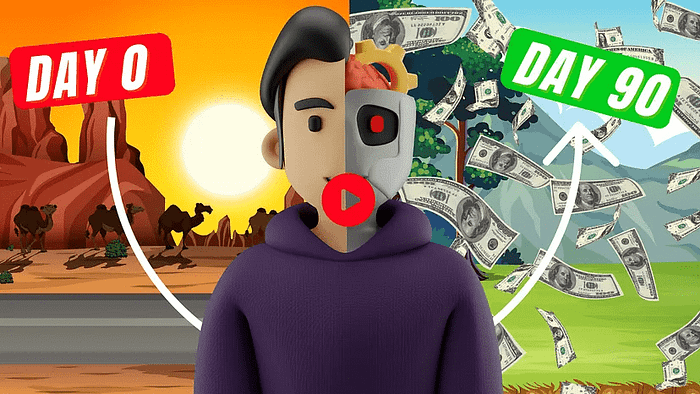How to Implement the Digital Product Millionaire Strategy: From $7 to $1 Million
Discovering the digital product millionaire strategy can transform your online business journey. This approach challenges conventional wisdom about pricing and profit margins in the digital marketplace.
Let’s dive into how you can leverage low-ticket items to build a seven-figure empire.
We strongly recommend that you check out our guide on how to take advantage of AI in today’s passive income economy.
Table of Contents
Understanding the Low-Ticket Model
What Are Low-Ticket Products?
Low-ticket products are digital offerings priced at an impulse-buy level. These items typically cost less than $100, with many successful entrepreneurs focusing on the $7 to $50 range.
The allure of these products lies in their accessibility to a wide audience. Customers feel comfortable making quick purchasing decisions at this price point.
The Appeal of Low-Ticket Products
Creating and selling low-ticket items can seem like an attractive business model at first glance. The idea is simple: sell many units at a low price to generate substantial revenue.
This approach appears to offer a win-win scenario. You provide value to customers without breaking their bank, while potentially reaching a larger audience than with higher-priced offerings.
The Challenge of Scale
However, the reality of scaling a business solely on low-ticket products presents significant challenges. Let’s consider the math:
To reach a six-figure annual revenue with a $50 product, you’d need to sell 2,000 units. For a seven-figure income, that number jumps to 20,000 sales.
These figures don’t account for operating costs, marketing expenses, or the substantial effort required to manage such a high volume of customers.
The Digital Product Millionaire Strategy Unveiled
The Game-Changing Shift
The digital product millionaire strategy introduces a crucial twist to the low-ticket model. Instead of relying solely on your initial offering, you create a sales funnel with higher-priced products.
This approach transforms your low-ticket item from a profit center into a customer acquisition tool. It becomes what’s known as a “self-liquidating offer” – a product that covers its own marketing costs.
The Power of the Upsell
Once a customer purchases your low-ticket item, they’ve crossed an important threshold. They’ve demonstrated trust in your brand and a willingness to invest in your solutions.
This moment presents a golden opportunity to offer additional, higher-priced products or services. These upsells are where the real profit potential lies in the digital product millionaire strategy.
Creating Your Product Ladder
To implement the digital product millionaire strategy effectively, you need to develop a range of offerings at different price points. This “product ladder” might look something like this:
- Entry-level product: $7 – $50
- Mid-tier offering: $97 – $497
- High-ticket program: $997 – $5,000+
Each step of the ladder provides increasing value and more personalized attention from you or your team.
Implementing the Digital Product Millionaire Strategy
Step 1: Crafting Your Low-Ticket Offer
Your entry-level product should provide genuine value while leaving the customer wanting more. It could be an ebook, a short course, or a toolkit relevant to your niche.
The key is to make it irresistible at its price point. Remember, the goal isn’t to profit from this product directly, but to acquire customers cost-effectively.
Step 2: Developing Your Sales Funnel
After a customer purchases your low-ticket item, immediately guide them towards your next offering. This could be through a “thank you” page that invites them to a free webinar or an email sequence that introduces your higher-tier products.
The digital product millionaire strategy relies on striking while the iron is hot. Your new customer is in a buying mood – capitalize on this momentum.
Step 3: Nurturing Long-Term Relationships
Don’t forget about your customers after their initial purchases. The digital product millionaire strategy emphasizes the lifetime value of a customer.
Implement an email marketing campaign that provides ongoing value, builds trust, and periodically introduces new offerings. Some customers may not be ready for your higher-priced products immediately, but could become big spenders months or even years down the line.
Mastering the Art of Upselling
The Webinar Approach
One effective method within the digital product millionaire strategy is to use webinars as a bridge between your low-ticket and high-ticket offerings.
Invite customers who’ve purchased your entry-level product to a free training session. During this webinar, provide additional value related to your niche, then introduce your premium offering as the ultimate solution to their problems.
The Email Sequence
Another powerful tool in the digital product millionaire strategy toolkit is the automated email sequence. After a customer buys your low-ticket item, enroll them in a series of emails that:
- Welcomes them and ensures they’re using their purchase
- Provides additional tips and value
- Shares success stories from other customers
- Introduces your higher-tier offerings
This approach allows you to nurture leads over time, increasing the likelihood of future purchases.
Overcoming Challenges in the Digital Product Millionaire Strategy
Managing Customer Volume
One potential drawback of the digital product millionaire strategy is dealing with a high volume of customers. Implement robust customer service systems to handle inquiries efficiently.
Consider using chatbots, FAQ pages, and automated email responses to address common questions. This frees up your time to focus on creating new products and marketing strategies.
Maintaining Product Quality
As you scale your business using the digital product millionaire strategy, it’s crucial to maintain the quality of your offerings. Your low-ticket product might be your customer’s first interaction with your brand – make sure it leaves a positive impression.
Regularly update your products, incorporate customer feedback, and strive to over-deliver at every price point. This approach builds trust and increases the likelihood of upsells.
Balancing Marketing Spend
The digital product millionaire strategy relies on effectively acquiring customers through your low-ticket offer. Monitor your advertising costs closely to ensure you’re not spending more to acquire a customer than you’re earning from your entry-level product.
Continuously test and refine your marketing messages, targeting, and ad placements to optimize your customer acquisition costs.
Advanced Tactics for the Digital Product Millionaire Strategy
Leveraging Affiliate Marketing
Expand your reach by creating an affiliate program for your products. Other entrepreneurs in your niche can promote your low-ticket item, bringing new customers into your funnel.
Ensure your commission structure incentivizes affiliates while still allowing you to profit from upsells and higher-tier offerings.
Implementing Scarcity and Urgency
Incorporate limited-time offers or bonuses to encourage quick decision-making. This could involve adding a countdown timer to your upsell page or offering special bonuses for customers who upgrade within a certain timeframe.
Remember, the key to the digital product millionaire strategy is moving customers up your product ladder efficiently.
Personalizing the Customer Journey
Use data from your customers’ interactions with your low-ticket product to personalize their experience. If your entry-level ebook has chapters on different topics, for example, you could tailor your upsell offers based on which chapters a customer spends the most time reading.
This level of personalization can significantly increase your conversion rates on higher-ticket items.
Measuring Success in Your Digital Product Millionaire Strategy
Key Metrics to Track
To ensure your digital product millionaire strategy is working, monitor these crucial metrics:
- Customer Acquisition Cost (CAC)
- Lifetime Customer Value (LTV)
- Conversion rates at each stage of your funnel
- Average Order Value (AOV)
Regularly analyzing these figures allows you to identify areas for improvement and optimize your strategy.
Continual Optimization
The digital product millionaire strategy isn’t a “set it and forget it” approach. Continuously test different price points, product offerings, and marketing messages.
Use A/B testing on your sales pages and email campaigns to refine your approach. Small improvements in conversion rates can lead to significant increases in revenue over time.
Scaling Your Digital Product Empire
Expanding Your Product Line
As you master the digital product millionaire strategy with one product line, consider expanding into related niches. Use the knowledge and systems you’ve developed to create new funnels and reach new audiences.
Building a Team
As your business grows, you may need to build a team to handle increased demand. Consider hiring virtual assistants for customer service, copywriters for marketing materials, and tech experts to manage your digital infrastructure.
Automating Your Systems
Leverage technology to automate as much of your business as possible. Use tools like CRM systems, email marketing platforms, and payment processors that integrate seamlessly.
Automation allows you to scale your digital product millionaire strategy without a proportional increase in work hours.
Conclusion: Your Path to Digital Product Millions
The digital product millionaire strategy offers a powerful framework for building a profitable online business. By using low-ticket products as a customer acquisition tool and focusing on upsells and long-term customer value, you can create a scalable, profitable enterprise.
Remember, success with this strategy requires patience, persistence, and a willingness to continuously learn and adapt. Start small, test your approach, and gradually refine your funnel.
With dedication and the right strategy, your journey from $7 products to a seven-figure business is within reach. Embrace the digital product millionaire strategy, and watch your online empire grow.
Frequently Asked Questions:
How can I be successful in selling digital products?
Success in selling digital products hinges on several key factors:
- Identify a clear target audience and their specific needs.
- Create high-quality products that provide genuine value to your customers.
- Develop a strong digital product millionaire strategy that includes both low-ticket and high-ticket offerings.
- Implement effective marketing techniques, including content marketing and social media promotion.
- Build an engaged email list to nurture relationships with potential and existing customers.
- Continuously gather and act on customer feedback to improve your products and services.
- Optimize your sales funnel to guide customers from low-ticket to high-ticket purchases.
- Provide excellent customer support to build trust and encourage repeat business.
- Stay updated with industry trends and adapt your offerings accordingly.
- Leverage automation tools to streamline your business processes and scale efficiently.
How do you create a digital product strategy?
Creating an effective digital product strategy involves several steps:
- Market research: Identify your target audience and their pain points.
- Product ideation: Brainstorm digital products that solve these pain points.
- Competitive analysis: Study your competitors to find gaps in the market.
- Product development: Create your digital products, focusing on quality and user experience.
- Pricing strategy: Implement the digital product millionaire strategy with a range of price points.
- Sales funnel design: Develop a funnel that guides customers from low-ticket to high-ticket offerings.
- Marketing plan: Create a comprehensive plan to reach and engage your target audience.
- Launch strategy: Plan a compelling launch to generate buzz and initial sales.
- Customer retention: Develop strategies to keep customers engaged and encourage repeat purchases.
- Continuous improvement: Regularly gather feedback and update your products and strategies.
Can you really make money on digital products?
Absolutely! The digital product industry offers significant profit potential for several reasons:
- Low overhead costs: Digital products don’t require physical storage or shipping.
- Scalability: You can sell the same product multiple times without additional production costs.
- Global reach: The internet allows you to reach customers worldwide.
- Passive income potential: Once created, digital products can generate income with minimal ongoing effort.
- Flexibility in pricing: The digital product millionaire strategy allows for a range of price points.
- High profit margins: Without physical production costs, margins can be substantial.
- Easy updates: You can continually improve your products based on feedback.
- Diverse product types: From ebooks to online courses, there are numerous options to explore.
- Automation possibilities: Many aspects of selling digital products can be automated.
- Growing market: The demand for digital products continues to increase globally.
What is the best strategy to sell digital products?
The most effective strategy for selling digital products is the digital product millionaire strategy, which involves:
- Creating a low-ticket entry product to attract customers.
- Using this product as a self-liquidating offer to cover marketing costs.
- Developing a range of higher-priced products or services.
- Implementing an effective upsell funnel to guide customers to these higher-ticket items.
- Nurturing customer relationships through email marketing and providing ongoing value.
- Leveraging webinars or video content to showcase your expertise and promote premium offerings.
- Using scarcity and urgency tactics to encourage quick decision-making.
- Implementing an affiliate program to expand your reach.
- Continuously optimizing your sales funnel based on data and customer feedback.
- Focusing on customer lifetime value rather than just initial sales.
This strategy allows you to acquire customers cost-effectively while maximizing revenue through strategic upsells and long-term customer relationships. Remember, the key to success is providing genuine value at every price point and consistently meeting or exceeding customer expectations.

We strongly recommend that you check out our guide on how to take advantage of AI in today’s passive income economy.




